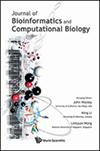RNA修饰对胃癌肿瘤微环境的影响及靶向药物治疗前景
IF 0.7
4区 生物学
Q4 MATHEMATICAL & COMPUTATIONAL BIOLOGY
Journal of Bioinformatics and Computational Biology
Pub Date : 2022-03-14
DOI:10.1142/S0219720022500044
引用次数: 0
摘要
背景:RNA腺苷修饰对调节RNA水平至关重要。N6-甲基腺苷(m6A)、N1甲基腺苷(m1A)、腺苷到肌苷的RNA编辑和选择性多腺苷酸化(APA)是四种主要的RNA修饰类型。方法:我们评估了27种RNA修饰酶的mRNA表达谱,并使用无监督聚类法比较了两种RNA修饰模式在肿瘤微环境(TME)和临床预后方面的差异。然后,我们构建了一个评分系统WM_score,并量化了癌症(GC)患者的RNA修饰,将WM_score与TME、临床结果和靶向治疗的有效性相关联。结果:RNA腺苷修饰与TME密切相关,可预测TME细胞浸润程度、遗传变异和临床预后。根据高和低WM_scores确定了两种改性模式。WM_score-high亚组中的肿瘤与生存优势、CD4[公式:见正文]T细胞浸润、高肿瘤突变负荷和细胞周期信号通路密切相关,而WM_score-low亚组的肿瘤显示炎症细胞浸润强烈,生存率低。关于免疫治疗反应,高WM_score与PD-L1表达显著相关,预测PD-L1阻断治疗的效果。结论:WM_ scoring系统有助于GC预后的评分和预测。本文章由计算机程序翻译,如有差异,请以英文原文为准。
RNA modification writers influence tumor microenvironment in gastric cancer and prospects of targeted drug therapy
Background: RNA adenosine modifications are crucial for regulating RNA levels. N6-methyladenosine (m6A), N1-methyladenosine (m1A), adenosine-to-inosine RNA editing, and alternative polyadenylation (APA) are four major RNA modification types. Methods: We evaluated the altered mRNA expression profiles of 27 RNA modification enzymes and compared the differences in tumor microenvironment (TME) and clinical prognosis between two RNA modification patterns using unsupervised clustering. Then, we constructed a scoring system, WM_score, and quantified the RNA modifications in patients of gastric cancer (GC), associating WM_score with TME, clinical outcomes, and effectiveness of targeted therapies. Results: RNA adenosine modifications strongly correlated with TME and could predict the degree of TME cell infiltration, genetic variation, and clinical prognosis. Two modification patterns were identified according to high and low WM_scores. Tumors in the WM_score-high subgroup were closely linked with survival advantage, CD4[Formula: see text] T-cell infiltration, high tumor mutation burden, and cell cycle signaling pathways, whereas those in the WM_score-low subgroup showed strong infiltration of inflammatory cells and poor survival. Regarding the immunotherapy response, a high WM_score showed a significant correlation with PD-L1 expression, predicting the effect of PD-L1 blockade therapy. Conclusion: The WM_scoring system could facilitate scoring and prediction of GC prognosis.
求助全文
通过发布文献求助,成功后即可免费获取论文全文。
去求助
来源期刊

Journal of Bioinformatics and Computational Biology
MATHEMATICAL & COMPUTATIONAL BIOLOGY-
CiteScore
2.10
自引率
0.00%
发文量
57
期刊介绍:
The Journal of Bioinformatics and Computational Biology aims to publish high quality, original research articles, expository tutorial papers and review papers as well as short, critical comments on technical issues associated with the analysis of cellular information.
The research papers will be technical presentations of new assertions, discoveries and tools, intended for a narrower specialist community. The tutorials, reviews and critical commentary will be targeted at a broader readership of biologists who are interested in using computers but are not knowledgeable about scientific computing, and equally, computer scientists who have an interest in biology but are not familiar with current thrusts nor the language of biology. Such carefully chosen tutorials and articles should greatly accelerate the rate of entry of these new creative scientists into the field.
 求助内容:
求助内容: 应助结果提醒方式:
应助结果提醒方式:


